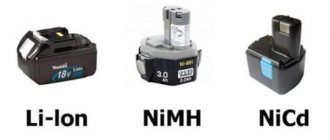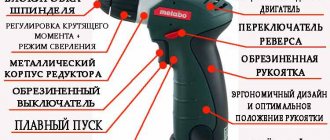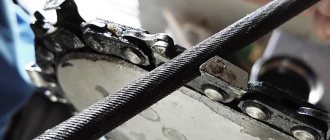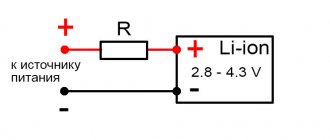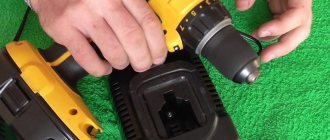Rating of the best 18650 batteries
| Place | Model | ||
| 1. | Battery Li-Ion 2500 mAh SAMSUNG INR18650-25R 1 pc | Prices | Review |
| 2. | Battery 18650 Samsung INR18650-25S, 2500mAh 35A | Prices | Review |
| 3. | Battery Li-ion SONY US 18650 VTC5 2600 mAh 30 A 3.7V | Prices | Review |
| 4. | Battery Li-ion SONY US 18650 VTC5A 2600 mAh 35 A 3.7V (1 pc.) | Prices | Review |
| 5. | Battery Li-ion SONY US 18650 VTC6 3000 mAh 30 A 3.7V (1 pc.) | Prices | Review |
| 6. | Battery LiitoKala 18650 Li-ion 3.7V 3400mAh unprotected (NCR18650B) 5 pcs. | Prices | Review |
| 7. | Battery LiitoKala HG2 18650 Li-ion 3.7V 3000mAh unprotected 5 pcs | Prices | Review |
| 8. | 18650 3350mAh Panasonic NCR18650B 3.6V unprotected Li-Ion battery | Prices | Review |
Features of using 18650 batteries for a screwdriver
Lithium-ion battery device.
In terms of design, a lithium-ion power source is not much different from batteries that use different chemistry. The difference is that it uses an anhydrous electrolyte - that is, free hydrogen is not released during operation. This is precisely what the structures used previously suffered from, which often became the cause of fire.
The anode of the element is a cobalt oxide film, which is applied to a current-collecting aluminum base. The cathode is an electrolyte containing liquid lithium salts. The working medium impregnates the porous mass, which conducts electric current. Typically, the electrically conductive material is loose graphite or coke. The current is removed from the copper plate located on the back side of the cathode.
For a battery to work properly, its cathode must be pressed tightly against the anode. For this reason, the lithium cell is equipped with a spring that compresses the anode, cathode and current collector. If air gets into the “body,” the balance of chemical processes will be disrupted. And the penetration of moisture will even cause a fire, or even an explosion. Therefore, the finished battery requires careful sealing.
There are flat-plate lithium power supplies. They are simpler in design, yet more compact and produce considerable currents. But flat batteries are designed for specific devices, that is, they are highly specialized and more expensive than their standard counterparts.
To expand the sales market, they produce batteries of universal shape and size. The most popular option is 18650. Visually, the power source resembles a regular AA battery, only increased in size.
For Li-Ion screwdrivers, batteries are assembled in series, making them a single battery. This increases the voltage supplied to the motor. And along with the voltage, the power and torque parameters increase.
Temperature sensors and a controller are required in the battery. The latter has several functions:
- ensures that power supplies are evenly charged;
- control of charging currents;
- Prevents over-discharge and overheating.
Along with lithium-ion batteries, there are lithium-polymer batteries. The difference is in the materials and design of the electrolyte.
Advantages and disadvantages
Among the variety of power sources, Li-Ion batteries are characterized by the following features:
- high electrical capacity. Due to this advantage, it is possible to design compact and lightweight hand-held power tools. Of course, there are heavy tools, which means they have a much more powerful battery;
- Lithium cells charge relatively quickly. On average, they receive a full charge in 2 hours. But there are special chargers with which the time required for charging is reduced to half an hour.
Along with the advantages, it is worth considering a number of disadvantages:
- are not able to work in frosty conditions. The screwdriver will work, but not for long, since the battery capacity drops significantly in cold weather. Of course, a power tool can be warmed up, thereby restoring the battery capacity, but this is inconvenient;
- service life, at best, is 3 - 5 years. No matter what manufacturers say, after just a year of operation, the battery loses up to a third of its energy capacity. It is considered normal if the Li-Ion battery lasts a couple of years;
- lithium power supplies are more expensive than the default nickel-cadmium ones.
Decoding the 18650 markings
The numbers 18650 mean the following:
- 18 mm - battery diameter;
- 65 mm - battery length.
Additionally, depending on the composition of the battery, the following marking is given:
- IMR , where I is lithium-ion technology, M is manganese oxide (LiMn2O4 or LiMnO2), R means Rechargeable;
- ICR , where C is cobalt oxide (LiCoO2);
- INR , where N is nickel oxide - Li(NiCoAl)O2 or Li(NiCoMn)O2;
- IFR , where F is iron phosphate LiFePO4;
- LCO , where L is lithium, CO is cobalt oxide;
- NCM , where N is nickel, C is cobalt and M is manganese;
- NCA , where N is nickel, C is cobalt and A is aluminum;
- LMO , where L is lithium, MO is manganese oxide;
- LFP , where L is lithium, FP is iron phosphate;
- NCR , where N is nickel, C is cobalt, R is a rechargeable battery.
Conversion of a screwdriver to lithium batteries 18650 14 V
When converting screwdrivers of different power and flashlights from Ni-Cd to Li-ion, 18650 form factor batteries are more often used. They easily fit into a container or socket, since instead of two or three original ones they install one lithium one. The modification of the screwdriver battery should be carried out taking into account the features of 18650 lithium batteries.
This type of energy source does not tolerate deep discharge and excessive charge. This means that it is necessary to use voltage control boards. Since each battery has its own character, their charge is adjusted by a balancer. The point of converting a screwdriver with a voltage of 14.4 V is to create a device using lithium batteries to make a hand tool lighter and improve its performance. 18650 lithium batteries are most suitable for these purposes.
When selecting components, it should be taken into account that the starting current of the screwdriver is high; you must select the appropriate BMS for the required number of cans and at least 30 A. To convert the charging of the screwdriver to a lithium battery, you need to stock up on a good soldering iron, non-acid flux and thick wires for making jumpers.
Equipment:
- Lithium-ion cans in the amount of 4 pcs.
- Li-ion battery controller for 4 banks, CF-4S30A-A fits well. It has a built-in balancer that controls the charge of each element.
- Hot melt adhesive, TAGS soldering flux, solder.
- Heat-resistant tape;
- Connecting jumpers or thick insulated wire with a cross-section of at least 0.75 square, cut for bridges.
The procedure for converting a screwdriver for 18650:
- Disassemble the case and remove a bundle of 12 Ni-Cd elements from the container.
- Remove the garland, leaving the connector with the “+” and “-” terminals. Instead of a temperature sensor, a thermocouple from the controller will be installed.
- Solder the assembly, taking into account that you cannot use acid, only neutral flux and clean solder. During the connection period, the lids must not be heated. Work precisely.
- Connect balancing points to the controller according to the diagram. There are connectors on the board.
- Connect the assembly to the plus and minus terminals.
- Check the functionality of the circuit. If everything works, place the assembled battery, place the controller in the socket, and secure it with sealant.
If the memory is not universal, additional rework will be required. 12 V screwdrivers with a universal charger are assembled in the same way, but a protective circuit for connecting 3x18650 3.7 V to lithium batteries is used. A screwdriver is converted in the same way using a 18650 battery kit consisting of 2 elements.
Tips for choosing a 18650 battery
There is quite a lot of information on the network about which 18650 is suitable for a screwdriver. In some places it is contradictory or does not correspond to reality. To buy the right lithium battery for your tool, you need to pay attention to important characteristics.
Current limits
Lithium-ion batteries are divided into 2 types:
- High current (capable of delivering > 10 A current without harming the battery).
- Low current (provide up to 10 amperes of current or less). When operating with a current greater than 10 A, the battery may fail and the voltage may drop.
At idle, the least amount of current is consumed - up to 2 A. When operating with fasteners or a drill, household screwdrivers reach 10-20 A , professional units - 40-50 A. Accordingly, in short-term mode, household tools can withstand up to 30-40 amperes , professional ones - up to 60-80 amperes of current.
To avoid a strong voltage drop and a decrease in power under load, it is recommended to reduce the internal resistance of the battery.
Availability of built-in controller
The 18650 battery device may or may not include a controller that monitors charge amount, temperature, and load current.
Such a controller is located in front of the negative terminal on top of the housing.
Controller
Installing breakers is not necessary when batteries are used, for example, to create a current of 12 volts and there is a common charge controller.
List of known microcircuits used by controllers:
- DW01+ . It consists of a 6-leg board and field-effect transistors connected by a special assembly into one housing. Transistors create a measuring shunt. Thanks to parasitic LEDs, it is possible to charge the battery even when the mechanism protecting against deep discharge is activated.
- LV5114OT - triggers at voltage from 2.5 to 4 V ;
- S-8241 Series - triggered at a voltage of 2.3-4.3 V ;
- R5421N - triggered when overcharging.
Presence or absence of battery protection
Li-Ion batteries exist with and without protection. A special board that performs certain functions is responsible for protection:
- short circuit prevention;
- protection against overdischarge at voltage < 3 V and against overcharge at voltage > 4 V.
Battery protection
It is allowed to use only batteries without protection, because the protective board is triggered at a current of 6-10 amperes , and working with the tool requires a current of more than 10 A under load. Accordingly, the screwdriver cannot operate when using a protected battery.
Types of batteries for screwdrivers and their features
Modern cordless screwdrivers and drills use three types of batteries:
- Nickel-cadmium (NiCd, Ni-Cd).
- Nickel metal hydride (Ni-MH or NiMH).
- Lithium-ion (Li-ion).
Let us consider the features of each type of battery in detail.
Nickel-cadmium
This type of energy source is perhaps the oldest. Cadmium batteries appeared in the 70s, and it was a real breakthrough. Compared to lead-acid and alkaline batteries, nickel batteries turned out to be much more compact with the same electrical capacity and had a reasonable price.
Like lead-acid, Ni-Cd cells can deliver quite a large current to the load and withstand up to 1,000 charge/discharge cycles. Moreover, such a number of cycles is just a manufacturer’s guarantee. In fact, the battery continues to serve even after reaching this figure.
The charging time for a Ni-Cd battery is on average 6-8 hours, which, unfortunately, is a bit long, but still less than that of its acid and alkaline counterparts. Nickel batteries are also distinguished by their “frost resistance” - they work perfectly at temperatures down to -20 degrees Celsius. Additionally, cadmium technology allows deep discharge, and battery life depends mainly on the number of charge/discharge cycles. Such a battery can be stored for a long time - up to 7-8 years.
But this type of battery also has disadvantages, and significant ones. One of them is high self-discharge, which can reach 10% per month. Thus, if the screwdriver has been lying idle for, say, six months, then it will have to be charged before use.
Another drawback is the so-called “memory effect”. If the battery is constantly recharged without discharging to zero, then it will “remember” to what level it was discharged and upon reaching this threshold it will simply refuse to work, “saying” that it is discharged. That is why batteries of this type need to be periodically “chased” - completely discharged and immediately charged to 100%.
Expert opinion
Alexey Bartosh
Specialist in repair and maintenance of electrical equipment and industrial electronics.
Ask a Question
Important! The most significant disadvantage of Ni-Cd current sources is the presence of toxic components, in particular cadmium. This metal is not only toxic, but is a strong carcinogen and has a cumulative effect (can accumulate in the body). Therefore, cadmium batteries should not be thrown into the trash - they must be recycled.
Nickel metal hydride
This type of battery appeared a little later - in the early 90s of the last century. Ni-MH cells have characteristics similar to cadmium, but the memory effect is much weaker (but still manifests itself) and, most importantly, there is no cadmium in such batteries.
Ni-MH battery for screwdriver
A nickel-metal hydride battery is capable of delivering decent current, works well in cold weather, and its self-discharge is the same 7-10% per month. As for the cost, batteries of this type are somewhat more expensive than cadmium ones, but the number of charge/discharge cycles, on which the service life depends, is only 300-500 times, which is a significant disadvantage. The shelf life of such elements is 6-7 years. The size/capacity ratio, as well as the charging time - up to 8 hours, are similar to cadmium ones. Metal hydride cells, like cadmium cells, tolerate deep discharge well.
Lithium-ion
Li-Ion technology is advanced today. Lithium cells are much more compact and lighter than the previous ones with the same electrical capacity and, which is very convenient, can be charged with increased current. At the same time, the time to fully charge lithium-ion batteries can be reduced to 1-2 hours.
Li-Ion battery for screwdriver
The great advantage of this type of battery is the almost complete absence of memory effect - the tool can be recharged at any time and to any level. The self-discharge of Li-Ion batteries is relatively small and amounts to approximately 2-3% of capacity per month.
As for the disadvantages, until relatively recently there were high degrees of fire and explosion hazard. If used incorrectly, the battery could catch fire or even explode. Moreover, it is almost impossible to extinguish a burning element with water - this only intensifies the combustion.
Important! In recent years, this problem has been solved - lithium cells or batteries began to be equipped with controllers that monitor the behavior of the battery, its state of charge and temperature. However, if there is mechanical damage, such a battery can still catch fire today.
Another serious drawback of elements of this type is that they do not tolerate deep discharge and overcharging. In the first case, the battery immediately fails, in the second, it may catch fire. But this problem was also easily solved by the same controller, which disconnects the battery from the load during a critical discharge and from the charger if the battery is charged.
The typical lifespan of Li-Ion batteries is 600 charge/discharge cycles, but it also greatly depends on “age”. A lithium-ion battery can be stored for no more than 2-3 years, regardless of whether it is working or just lying on the table.
When choosing a tool with such batteries, you should take into account that they will behave poorly in the cold (a strong decrease in capacity, which, however, will be restored in warmth). In addition, they will not be able to deliver high current at any temperature, which means they will not provide the high torque required for working with dense materials. And the cost of Li-Ion elements is much higher than that of their nickel counterparts.
Healthy. In recent years, lithium polymer (Li-Pol) batteries have emerged. They have almost the same characteristics as ionic ones, but can deliver fairly high currents and charge a little faster.
The best batteries for a screwdriver
The rating of the best high-current 18650 batteries for a screwdriver will help you choose a battery suitable for your tool among a variety of models.
Battery Li-Ion 2500 mAh SAMSUNG INR18650-25R 1 pc
This model is the first among the best 18650 for a screwdriver. The battery without protection ensures stable operation and high discharge current with small dimensions. Universal lithium-ion battery for all devices. The part is sensitive to overheating (the use of a soldering iron is prohibited; instead, it is advisable to use welded contact pads). Supplied in cardboard packaging.
current strength - up to 20 amperes;
voltage - 3.7 volts;
number of charge cycles - 600;
capacity - 2.5 Ah.
Prices in online stores
Battery 18650 Samsung INR18650-25S, 2500mAh 35A
High-current lithium-ion battery for use in professional screwdrivers and other electronics. Battery without protection. It is recommended to use contact pads for installation instead of a soldering iron. The battery can withstand temperatures from -20 to 80 degrees during operation and up to 50 degrees when charging.
current strength - up to 35 amperes;
voltage - 3.6 volts;
number of charge cycles - 250;
capacity - 2.5 Ah;
weight - 47 g.
Prices in online stores
Battery Li-ion SONY US 18650 VTC5 2600 mAh 30 A 3.7V
Sony's latest generation lithium-ion battery for household screwdrivers. The battery is universal, without protection. It is possible to operate with high current strength with small dimensions. Permissible temperature during operation is from -20 to 60 degrees ; when charging - up to 40 degrees . After 500 recharges, the capacity can be reduced to 80% of the nominal.
current strength - up to 30 amperes;
voltage - 3.7 volts;
number of charge cycles - 500;
capacity - 2.6 Ah;
weight - 53 g.
Prices in online stores
Battery Li-ion SONY US 18650 VTC5A 2600 mAh 35 A 3.7V (1 pc.)
High power battery without protection. The battery is suitable for all types of equipment, including screwdrivers. After a certain number of recharges, the battery’s performance is maintained, but the capacity can be reduced by 20%. Storage at temperatures up to 45 degrees . The permissible temperature during operation is up to 80 degrees Celsius .
current strength - up to 35 amperes;
voltage - 3.7 volts;
number of charge cycles - 500;
capacity - 2.6 Ah;
weight - 50 g.
Prices in online stores
Battery Li-ion SONY US 18650 VTC6 3000 mAh 30 A 3.7V (1 pc.)
High current VTC6 . An ideal option for assembling battery packs intended for subsequent autonomous power supply of various types of equipment, including screwdrivers.
current strength - up to 30 amperes;
voltage - 3.7 volts;
number of charge cycles - 500;
capacity - 3 Ah;
weight - 45 g.
Prices in online stores
Battery LiitoKala 18650 Li-ion 3.7V 3400mAh unprotected (NCR18650B) 5 pcs.
A set of universal batteries from a Chinese brand. No protective boards are provided, so the parts are suitable for assembling batteries for screwdrivers. The batteries are made of nickel and cobalt, but the memory effect is very low. Failure is possible at a voltage of 2.5 V.
voltage - 3.7 volts;
number of charge cycles - 1000;
capacity - 3.4 Ah;
weight - 48 g.
Prices in online stores
Battery LiitoKala HG2 18650 Li-ion 3.7V 3000mAh unprotected 5 pcs
A set of universal lithium-ion batteries. A low percentage of self-discharge and the absence of a protective board are the main advantages for choosing these batteries for the purpose of assembling batteries for screwdrivers. At a voltage of 2.5 V and below, the battery fails.
current strength - up to 30 amperes;
voltage - 3.7 volts;
number of charge cycles - 1000;
capacity - 3 Ah;
weight - 48 g.
Prices in online stores
18650 3350mAh Panasonic NCR18650B 3.6V unprotected Li-Ion battery
Powerful universal battery for various types of equipment, including household and professional screwdrivers. Special nickel clips are welded to the platforms to facilitate the assembly of battery packs. At a voltage of 2.5 V, damage is possible.
current strength - up to 30 amperes;
voltage - 4.78 volts;
number of charge cycles - 500;
capacity - 3350 mAh;
weight - 50 g.
Prices in online stores
Types of drives
Most often, electric screwdrivers have a nickel-cadmium or lithium-ion battery. There are also Ni-Mg drives, which have their own advantages.
However, nickel-metal hydride batteries are rarely installed in screwdrivers, because the electrolytes heat up too quickly when charging. This is also very noticeable when working continuously with the tool.
Benefits of Nickel Metal Hydride Batteries
If you do not take into account the tendency to become very hot, Ni-Mg batteries have the following advantages:
- cause less damage to nature;
- less memory effect than others.
However, they are not able to compete with Ni-Kd and Ni-Li batteries. Therefore, batteries are not recommended due to their low efficiency.
In addition, they are almost never used in screwdriver designs.
Advantages of nickel-cadmium batteries
People criticize cadmium storage batteries because they are older. However, despite the numerous condemnations, these blocks have high performance. For example, they are more capacious and do not heat up as much during operation as the same nickel metal hydride battery cells.
This happens due to the heat-absorbing reactions that occur inside the battery. Heat absorption reaction is the absorption of generated heat inside an element. Such reactions do not release heat beyond the working mixture.
There are no heat absorption reactions in Ni-Mh. That's why they get so hot.
If you choose a battery cell for an electric screwdriver based on its practicality and productivity, then Ni-Cd is much better than Ni-Mh. Currently, they are the most common type of battery not only for electric screwdrivers or drills, but also for other household appliances.
Advantages of NI-CD batteries:
- Lower chance of overheating of block elements.
- They will not burn out or deteriorate in a short time, unlike Ni-Mg.
- Equipped with a durable and reliable metal casing, which provides good sealing of the structure.
- Resistant to various undesirable chemical reactions.
- Resistant to negative temperatures. They function even at -35°C.
- When used correctly, batteries last about 7-11 years.
- Adequate cost. Li Ion storage batteries cost much more.
To ensure that nickel-cadmium storage units do not break prematurely and last 7-11 years, you must adhere to certain operating rules.
First of all, remember that nickel batteries are not afraid of a complete discharge of the elements. Therefore, when working, discharge the storage unit to the very end.
After discharging, you can put the battery on charge, because it will not lose its capacity.
It is recommended to store batteries in a discharged state, because the reversible loss of capacity, or the so-called “memory effect,” will be less pronounced.
There is no need to recharge the battery during storage. Reversible loss of capacity is not a significant threat to the battery. To reduce damage from the “memory effect”, it is recommended to fully charge and discharge the battery several times. These manipulations will help reduce reversible loss of capacity.
Benefits of lithium-ion batteries
Compared to nickel-cadmium batteries, the Li Ion type of battery was invented relatively recently - in the 90s of the 20th century. In the beginning, this type of battery was dangerous due to the high risk of rupture. This was due to technical deficiencies.
Currently, most lithium-ion batteries are equipped with special sensors to monitor the heating of the elements and the charge level.
This design is more reliable, safe and efficient compared to the first samples.
What are the advantages of Li Ion batteries? Comparing them with nickel-cadmium and nickel-metal hydride batteries, one can notice that they have the following advantages:
- Can be used for a longer period of time thanks to its high capacity.
- No reversible loss of capacity (as stated by 99% of Li Ion battery manufacturers and sellers).
- A lithium battery pack has much less weight with the same capacity than a cadmium battery.
Due to its capacity, this type is more common in the technical field, where professionals use tools longer than nickel-cadmium battery packs.
Lithium batteries have a number of disadvantages. For example, they are more sensitive to even the smallest voltage surges during charging.
In contrast to cadmium, lithium-ion is more sensitive to low temperatures, especially when leaving a warm room outside in cold weather.
Of course, any type of battery is more or less sensitive to sudden temperature changes, but knowledgeable experts say that lithium-ion batteries are the most demanding.
Lithium-ion batteries lose their declared capacity faster if they are not used for a long time. Their service life is no more than two or two and a half years.
Characteristics influencing choice
When choosing a battery for a screwdriver, it is important to consider the characteristics that directly determine whether the device will satisfy the owner’s needs:
Compatibility
It is advisable, but not at all necessary, to use an original battery manufactured by the same company as the screwdriver itself. So Dewalt batteries are suitable for BlackEndAcker screwdrivers, and Hummer batteries are suitable for Hitachi.
The range of compatible screwdrivers is indicated on the battery packaging. Most often, devices from the same manufacturer and its subsidiaries will be listed there. The reasons for this, in addition to market competition, are the unique form factor of the screwdriver body and battery power. A tool can simply be ruined by installing a higher-power battery on it in an attempt to increase strength, while a weak one will limit its capabilities.
Interesting possibilities are opened up by lines of screwdrivers with a single battery for all devices:
- Ryobi ONE+;
— DeWALT XR Li-Ion;
— AEG Pro 18V;
— Bosch Power for All, etc.
Although the tool itself, which is part of this series, is not cheap, in the long term, the ability to not buy different batteries for a jigsaw and a screwdriver allows you to save money.
One+ line from Ryobi
Power
The rotation speed and power of the screwdriver directly depend on the battery voltage, measured in volts (V).
- low-power models, 3 - 10 V, are suitable for rare home use;
- for most repair work - 12 - 18 V;
— models with a voltage rating of 18–36 V are considered professional, suitable for regular work with hard materials and metals.
Capacity
The battery capacity shows how long it can work. It is measured in amperes multiplied by hours, i.e. a screwdriver with a capacity of 1.5 A*h produces up to 1.5 amperes per hour.
If 2 batteries have the same capacity, look at the voltage. The one with the higher value will last longer.
If you need to check the actual capacity of the battery - there are doubts about the integrity of the manufacturer or the correct operation of the screwdriver - this can be done using a household multimeter and a light bulb. Such a test will not give a 100% accurate indicator of capacity; for this you need a special device, but it will allow you to understand how close it is to the declared values. First, the battery must be charged and discharged 3 times. Measurements are carried out with a fully charged battery. The multimeter mode for testing is DC, 20 V. During normal battery operation, the readings should be close to those indicated in the technical specifications.
Measuring capacitance with a multimeter
Pros and cons of lithium-ion batteries
Battery technologies are constantly being upgraded and improved. For example, the use of lithium ferrophosphate cathodes is now widespread, instead of lithium cobaltate and nickelate, which change some characteristics of batteries for the better and reduce the price of the product.
Advantages
- High weight and volumetric energy density.
- The supply voltage of an individual cell (3.6 V) is higher than that of lead- or nickel-based batteries.
- Fast charging process, about 90% capacity in 0.5÷0.6 hours.
- Fair resource, more than 1000 discharge/charge cycles.
- Spontaneous discharge of no more than 5% of capacity per month.
- Construction materials are chemically safe during operation and disposal.
Negative aspects of the device design
- The rapid development of the aging process of the battery, after 5 years the characteristics sharply change for the worse, both during active use and during normal storage.
- The use of complex battery monitoring and management systems, leading to higher product prices.
- Mechanical damage or operation of the battery without a control board can lead to an explosion.
Like any other technical device, the battery requires care and attention. The higher the storage temperature, the more active the degradation of the characteristics of the lithium-ion drive occurs; optimal storage is at a temperature of 0÷20 °C. It is also recommended to charge batteries only at above-zero temperatures.
Crowns for concrete. Sizes and types
The difference between an impact drill and a hammer drill
